10 Best Flat Feet Exercises

Flat feet, also known as fallen arches, are a postural deformity which affect the arches of the feet. Individuals with flat feet either have low arches or no arch or curvature around the inner side of the sole of their foot; when they stand, the sole of their foot often makes complete contact with the ground.
This condition can cause pain and discomfort in some people as the arch of the foot plays a crucial role in body alignment and posture, therefore an absence of the arch can disrupt this balance.
We have compiled a list of our 10 best flat feet exercises you can do yourself easily at home to help relieve some of the painful symptoms associated with the condition.
Best Exercises For Flat Feet and Fallen Arches
Arch strengthening exercises for flat feet can help reduce some of the discomfort you may be experiencing and could even improve your posture in the long run.
Most of the exercises for flat feet are recommended even if you have partial flat foot, or a normal healthy foot arch, as the stronger your arches are, the less muscle fatigue you will feel in your feet and legs.
Each of these arch strengthening exercises for flat feet can be carried out daily in a matter of minutes in the comfort of your own home. They start at a beginner level and later made more challenging when you feel you are ready.
If you begin to feel any pain then stop. Remember, you can take a day off if your muscles are feeling sore and you think you need a rest.
1. Towel Scrunch
The towel scrunch is a simple exercise that strengthens the arches. It requires you to remain seated and the use of a single towel.
- Begin by sitting on a chair and laying a towel down flat at your feet.
- Grab at the towel using only the muscles in your toes until you can’t pull the towel any more under your foot.
It is recommended that you complete two sets of this exercise with each foot, starting once a day with a regular bath towel. Once you feel comfortable, you can begin to increase the amount of sets that you do.
2. Stair Heel Raises
To do stair raises you need to;
- Partially stand on a step with just your toes and the balls of your feet on the step.
- Slowly push in and raise the heel of your foot up into the air.
- Hold for a few seconds then relax and bring your feet back down. You need to resist the urge to lower your heel below the stair line in order for this exercise to be effective.
Initially start with 10 stair raises as one set, and aim to be able to accomplish 3 sets a day without pain.
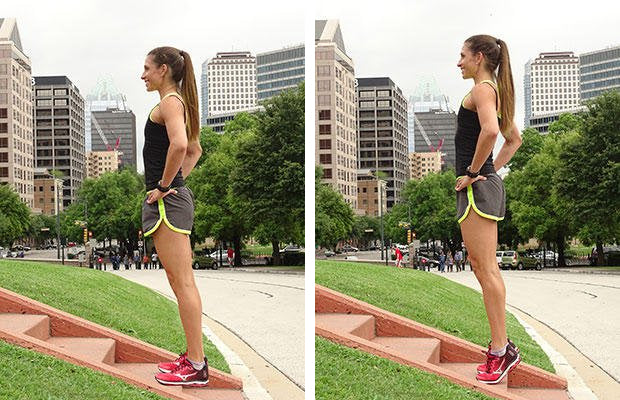
3. Toe Extension
An easy stretch of the toe extensor muscles, the toe extension stretch focuses on the muscles which are on the top part of the foot that help to control the movement of your toes.
- Gently push down on the toe fingers until the knuckles are prominent and hold for twenty seconds.
- Repeat the stretch 3-4 times per session to improve strength and flexibility.
4. Towel Stretch
A towel stretch can stretch the Achilles tendon and relieve tightness or inflammation in these tendons.
- Begin by sitting on the floor and loop a towel around the balls of your feet.
- Make sure that your torso and knees remain straight and begin to pull the towel towards yourself until you can feel the Achilles tendon stretching.
- Hold for thirty seconds, release and repeat.
Repeat this stretch 10 times, once a day. Resistance bands are a safe and easy alternative for stretching.
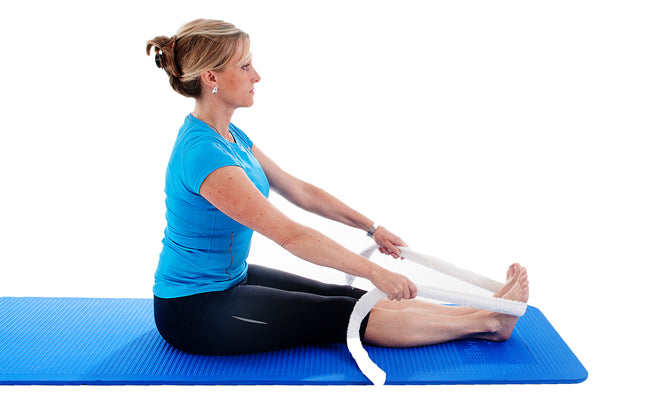
5. Stork Stretch
Stand with one foot on the ground and slowly raise your other foot to increase the pressure on the foot which is on the ground.
- Imagine that someone is raising your foot from the arch and increase the pressure on your heels. (If you require support, you can stand near a wall or some furniture.)
- Hold the position for 10 seconds as your muscles stretch, then release and repeat on the other foot.
6. Foot Roller
- Remain seated and place a foot roller or a frozen drinking can on its side in front of you.
- Use moderate pressure and push down on the can with the ball of your foot then roll the roller back towards your heel.
This exercise not only stretches the foot, it also massages it and can help relieve soreness in the arch.
7. Heel Raise
Stand with both your feet flat on the floor; you can hold onto something if you need the support.
- Push up using just the balls of your feet and raise your heels off of the floor.
- Hold this position for a few seconds then gradually lower yourself back down.
You can make this more challenging by placing a small object between your ankles and holding it throughout the movement, aim to complete 3 sets of heel raises 10 times a day.
8. Plantar Fasciitis Stretch
- Place your feet against a wall and keep your arches and heels as flat as possible so that the toes can stretch. You can also place a tennis ball or foam roller in front for more comfort and support.
- Hold the stretch for ten seconds.
Aim to repeat this exercise 10 times per set, 3-4 times a day.
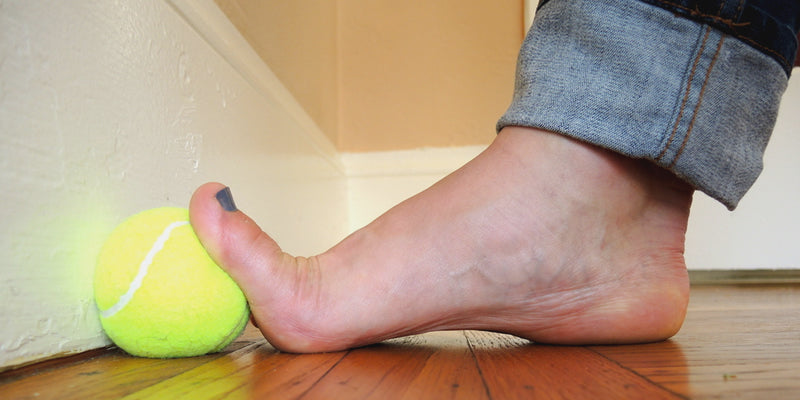
9. Toe Crawl
- Start by sitting up straight in a chair and keep both your feet flat on the floor.
- Scrunch up the toes of your feet as if you are trying to grab the floor.
- Now use your toes to drag your entire foot forward as if your foot is crawling.
You can do this for as long as feels comfortable with both your feet, but make sure that you are not using your leg muscles to push your feet forward – the ‘crawl’ should come from the muscles in your feet only.
10. Go Barefoot
As well as all of the above exercises and stretches, simply going without shoes for some time everyday can help strengthen your feet. Research has shown that spending time barefoot can strengthen your muscles, bones, tendons and ligaments in your feet.
You can walk barefooted at the park, at the beach and even use a foot massage mat to exercise your feet.
Arch Supports For Flat Feet
Performing flat feet exercises to strengthen the arches are essential for the long term health of your feet. It’s a gradual process that should be done regularly to maintain the strength of the arches.
Despite of this, having flat feet or fallen arches still requires an adequate degree of support on a day-to-day basis, particularly if you’re experiencing weakness, numbness or pain.
There a number of different types of arch supports for flat feet:
- Flat Feet Insoles – Specially designed insoles for flat feet are construted in a way to support the arches. Choosing a firmer base over a softer one is recommended as it provides better support and alleviates pressure more effectively. You can also get custom made orthotics that are specifically designed for your feet only, though they’re a lot more expensive and in some cases, on par with the effectiveness of regular flat feet insoles.
- Arch Support Sleeves – Inexpensive and easy-to-wear, arch support sleeves have a firm underside – typically made from gel – that contours to the arch of the foot. Arch support sleeves can usually be worn with or without socks/shoes. Though the concept is the same as flat feet insoles in the sense that they’re designed to relieve pressure and provide support, they feel different when worn as they’re always wrapped around your feet rather than separated like insoles.
- Supportive and Well Fitting Shoes or Trainers – If you choose a well fitting pair of shoes that has decent arch support, then it’ll usually eliminate the need for arch support insoles. It’s often not easy trying to discover the perfect shoes for flat feet as comfort, type, cost and style need to match your expectations. Needless to say, you should always avoid footwear that’s too tight or loose, and offer little to no arch support.
So which option should you go for if you have flat feet?
The easiest and go-to solution for the majority of people with flat feet are to use specially designed insoles for flat feet; they’re often inexpensive, have a wider range on offer and can be used on different types of footwear.
At Feet&Feet, we offer a range of half insoles and full sized insoles designed to support flat feet. The majority of our full sized insoles can be trimmed down to size and all models are suitable for men and women.
Infographic
We've created an infographic for our "10 Best Flat Feet Exercises". Feel free to share it on social media or on your website/blog but please provide a backlink to this article and cite Feet&Feet as the source.
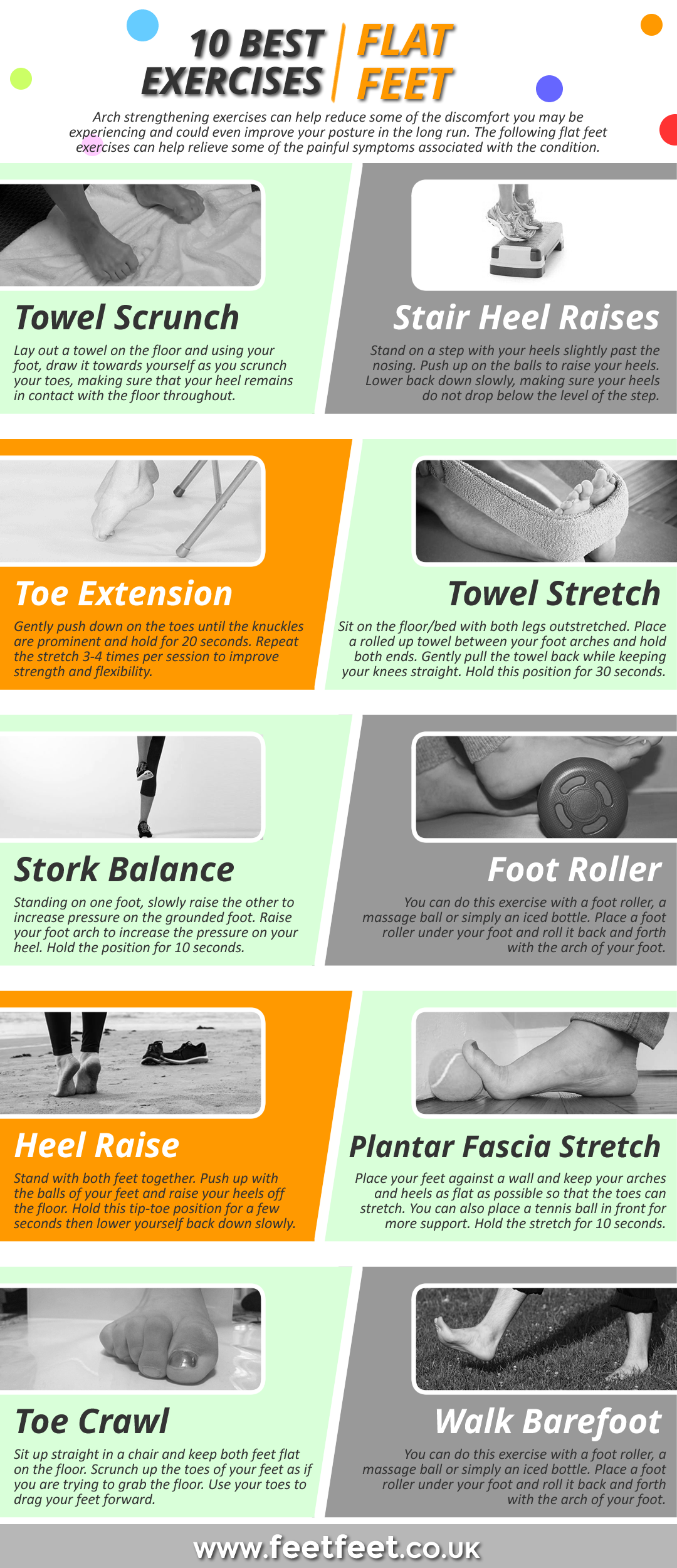
To enlarge the above infographic, right-click on the image and click "View Image".
Final Word | Best Flat Feet Exercises
Remember that despite our 10 best flat feet exercises being relatively easy to do, you should always consult with your doctor or physiotherapist who is aware of your condition before starting.
If you have excessive pain in your feet due to flat feet, your doctor may be able to prescribe you pain relief or help you find suitable orthotic devices you can wear for foot support.

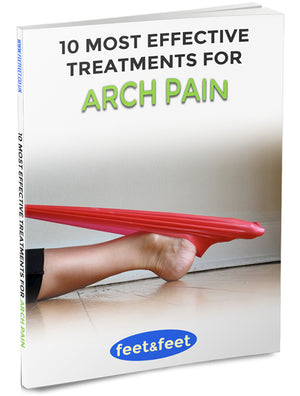
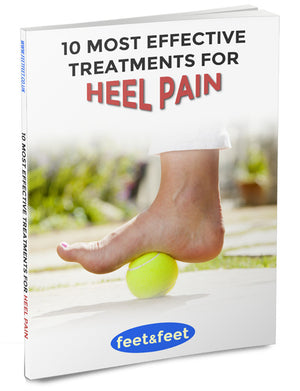



Leave a comment